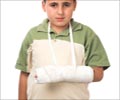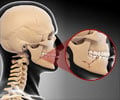- Rib injuries - (https://www.betterhealth.vic.gov.au/health/conditionsandtreatments/rib-injuries)
- Care of Rib Injuries - (http://patient.info/in/health/care-of-rib-injuries)
- The ribs - (http://teachmeanatomy.info/thorax/bones/ribcage/)
- Broken ribs - (http://www.mayoclinic.org/diseases-conditions/broken-ribs/home/ovc-20169623)
- Broken or bruised ribs - (http://www.nhs.uk/conditions/rib-injuries/pages/introduction.aspx)
- What is Osteoporosis and What Causes it? - (https://www.nof.org/patients/what-is-osteoporosis/)
What is a Broken Rib?
A broken or a bruised rib is a condition in which one of the ribs cracks or breaks. It is also known as a rib fracture. Ribs usually break at the point of impact or where they are structurally weakest. It is usually caused by a fall or a blow to the chest and occasionally by violent bouts of cough.
It is a painful condition that makes breathing difficult. Occasionally there might be some swelling or tenderness at the sight of the broken or bruised rib.
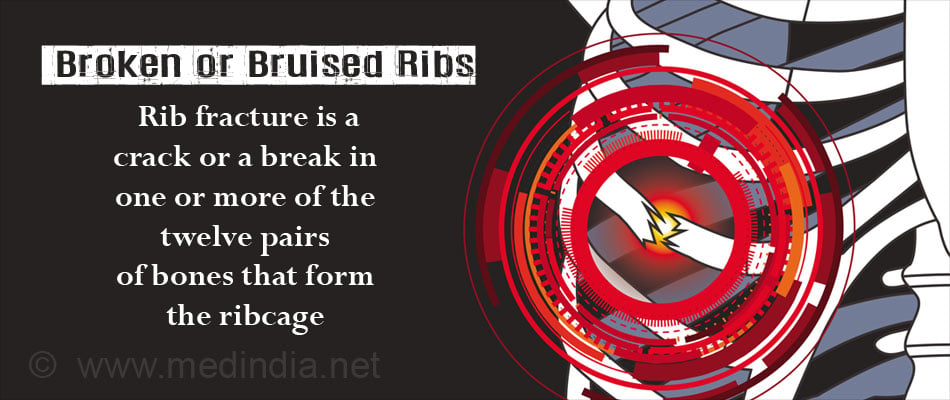
Sometimes, there is no fracture involved but severe bruising of the surrounding muscles may cause immense pain.
Anatomy of Ribs
Ribs are a set of 12 pairs of bones that form a protective cage around the thorax. The thorax holds the heart, lungs and protects some abdominal organs. Posteriorly, the ribs articulate with the vertebral column and anteriorly, they terminate at the costal cartilages that join the sternum or breast bone.
The costal cartilages are present only at the anterior ends of the ribs. They are hyaline cartilages that help the ribs to elongate and provide elasticity to the walls of the thorax.
The muscles between the ribs are called intercostal muscles. The ribcage is supported by muscles and ligaments that help it expand and collapse while breathing.
Ribs are divided into two basic groups- true and false ribs.
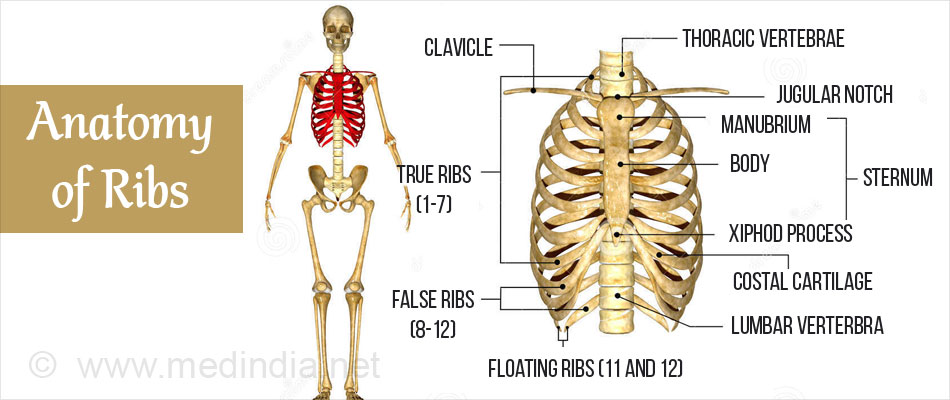
True and False Ribs
The 1st rib to the 7th rib constitute the proper ribs that are directly attached to the sternum via the costal cartilage.
The remaining 5 pairs (8th to the 12th) are known as false ribs. The first 3 among these are attached indirectly to the sternum over the cartilage of the 7th rib while the 11th and 12th ribs are called floating ribs as they are not connected the sternum.
Most common fractures occur in the 7th to 10th ribs. Fractures of the upper ribs are rare and when it happens, might cause damage the brachial nerve plexus, subclavian vessels or aorta. Fracture of lower ribs causes injury to the abdominal organs.
Main functions of the Ribs
- To protect the internal thoracic organs like the heart, lungs and important blood vessels.
- To aid in chest expansion during respiration.
- To prevent the thorax from collapsing by providing support.
Statistics on Broken Ribs
Rib fractures account for 10% to 15% of all traumatic injuries in the United States.
Nearly 300,000 people are said to fracture ribs annually and 7% of them require hospitalization.
About 54 million Americans have osteoporosis and by 2025, experts predict that osteoporosis will be responsible for three million fractures and $25.3 billion in costs annually.
What are the Types of Broken Ribs?
Simple or hairline fractures occur when a single rib gets fractured; they do not cause displacement of any bone segment.
Complex fractures occur when the edges of the ribs become misaligned and displaced.
What are the Causes of a Broken Rib?
A trauma to the chest or a fall causes rib fracture. Depending on the impact, a rib can either crack or break. A cracked rib though painful may not be as dangerous as a broken rib. A broken rib can cause damage to internal organs such as lungs or blood vessels by its jagged ends.
- Accident- Getting involved in a motor vehicle accident with direct impact on the chest breaks the ribs.
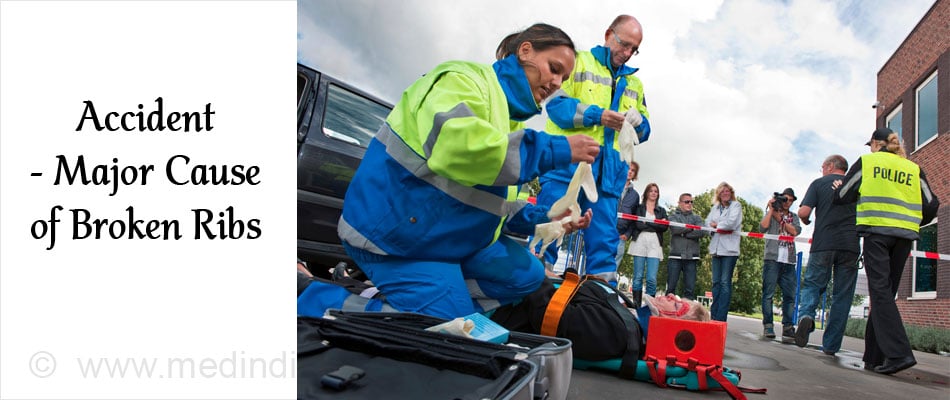
- Crush injury- When a heavy object lands on the chest.
- Fall- Falling from a reasonable height.
- Assault- Getting hit on the chest by objects like baseball bats or iron rod
- Sports- Engaging in contact sports like hockey or football.
- Repetitive trauma- Repetitive trauma from sports like golf or rowing.
- Cough- Violent coughing can crack ribs especially in older individuals.
- Osteoporosis- Osteoporosis causes the bone to lose its density or mass. As the bones becomes less dense, they weaken, become brittle and porous and are more likely to crack or break, especially in older individuals.
- Cancerous lesions- Cancerous lesions make the bones more brittle and weaker making it susceptible to breaks.
- Age- Older people are more likely to break their ribs due to degeneration of bones. Children and infants are less likely to break their ribs because of its high elasticity and flexibility.
Soft tissue can also get injured in certain situations. The intercostal muscles and the costal cartilage form the soft tissue of the ribcage.
- Intercostal muscle strain- Activities like extreme or forceful twisting of the body or swinging of the arms can cause straining of the intercostal muscles.
- Costochondral separation- In this case the rib is torn from the costal cartilage and detaches from the sternum.
What are the Symptoms of Broken Ribs?
One of the main symptoms of rib injury includes pain. The person might experience pain while
- Breathing- Inhalation may be painful causing shallow and erratic breath patterns
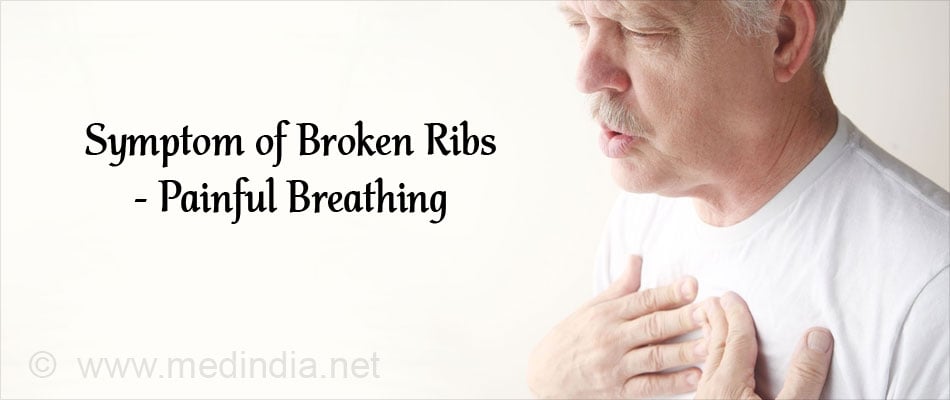
- Moving- Bending or twisting the body
- Pressing- Touching the injured site may also cause pain
- Coughing- Activities like coughing and sneezing that cause the ribcage to flex
Some other symptoms may include:
- Shortness of breath due to trouble breathing
- Muscle spasm of the ribcage
- Deformed appearance of the ribcage
- Crunching or grinding sound (crepitus), when the site of injury is touched
Less common symptoms may include:
- Dizziness
- Anxiousness
- Sleepiness
- Fear
- Restlessness
- Headache
What are the Risks and Complications associated with Broken Ribs?
The ribcage encloses vital organs like the heart and lungs and any trauma to the chest could be life-threatening.
Pneumothorax - The jagged or broken end of a rib can injure the lung and cause it to collapse. When the membrane around the lung gets damaged due to the broken rib, air leaks into the space between the lung and chest wall. This leaked air pushes on the outside of the lung making it collapse.
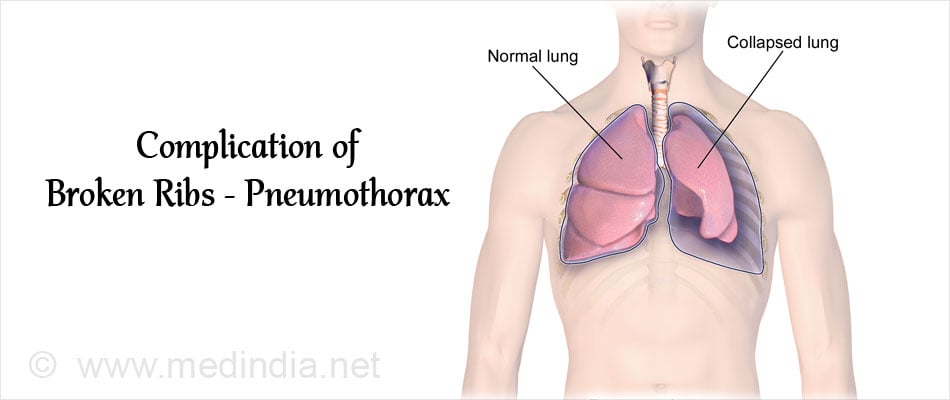
Symptoms include sudden chest pain, shortness of breath, pain on breathing and sometimes pain near the shoulder.
Usually only a part of the lung collapses. If it is small, it may heal on its own. Otherwise, it is treated by inserting a flexible tube or needle into the space between the ribs to remove the excess air.
Pneumothorax can become life-threatening if the air is trapped under pressure; this is known as tension pneumothorax. This causes increased breathing difficulty by compressing the lungs. It is a medical emergency.
Surgical Emphysema - When a sharp fractured rib causes the air from the lungs to lodge in the subcutaneous layer (the layer under the skin), it is called surgical emphysema. This causes a swollen area which may crackle on touch. It usually clears up on its own.
Hemothorax - It is similar to pneumothorax except that blood gets collected in place of air at the base of the lungs. It causes pain in the lower part of the chest and makes breathing difficult. It is treated by draining out the blood.
Aortic Rupture - The aorta is the main artery that carries oxygenated blood from the heart to the rest of the body. Fracture of the first three ribs can rupture the aorta or any other major blood vessel.
Abdominal Injuries - Fractures to the lower ribs can injure some abdominal organs like spleen, liver or kidneys. Symptoms include pain in the abdomen or back. If there is internal bleeding associated with organ rupture, the patient may feel faint and extremely unwell. It warrants immediate medical attention.
Chest infections - The pain due to rib fracture may interfere with coughing and breathing causing shallow breaths. This can lead to chest infections due to accumulation of mucus in the chest. It is therefore important to manage pain using pain-killers.
Flail Chest - It is a serious condition that occurs when three or more ribs break at multiple places displacing a bone segment that is free-floating. It occurs if there has been a great deal of blunt force. The main sign of flail chest is ‘paradoxical movement’. Here the natural movement of the ribcage during breathing is reversed. For example, the injured area of ribcage sinks in when the person inhales, instead of lifting outwards.
Injury causes changes to air pressure in the ribcage, which results in this reverse effect. Intubating the patient will restore normal pressure in the lungs.
How do you Diagnose a Broken Rib?
Physicians use the history as told by the patients to diagnose a broken rib.
During the physical examination, the doctor may palpate the area, listen to chest sounds and observe the movement of the ribcage during breathing.
X-rays- It uses low levels of radiation to view the bones, but it often fails in detecting fractures if the bone is merely cracked. It maybe useful in diagnosing a collapsed lung.
CT scan - This technology takes X-rays from a variety of angles and creates cross-sectional images of the internal structures. It helps in detecting injuries in the soft tissues and blood vessels.
MRI - The MRI uses powerful magnet waves to produce cross-sectional images. Apart from detecting soft tissue and organ damage, it also helps in detecting subtle rib fractures.
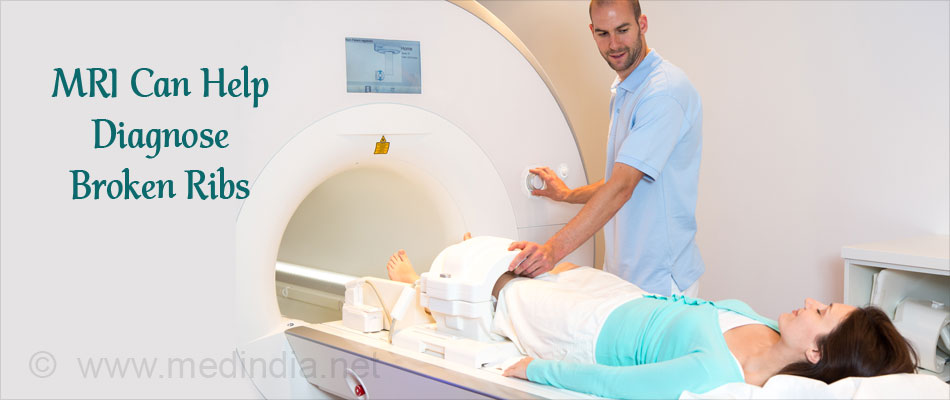
How do you Treat Broken Ribs?
Ribs usually heal on their own in about six weeks to three months.
Pain management - Bringing pain relief using painkillers is important. Good pain relief will help in proper breathing and coughing which is important to prevent infections like pneumonia.
Ice-pack - Holding an ice-pack for the first few days will help in reducing the pain and swelling.
Therapy - Once the pain is under control, the physician might prescribe breathing exercises to facilitate deep breathing.
Periodic Resting - Adequate resting is important to prevent strain and pain.
How do you Prevent yourself from getting a Broken Rib?
Protection - Protect yourself from sports related injuries by wearing protective pads or equipment.
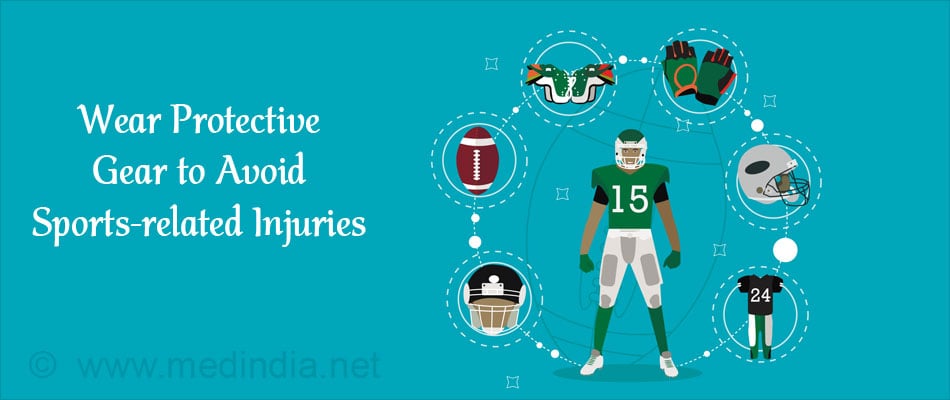
Prevent Falls - Especially among older people, care should be taken while moving around to prevent falls and landing on the chest. It is important to de-clutter the surroundings to reduce the chances of tripping.
Healthy Bones - It is important to maintain bone health by including adequate calcium and vitamin D in the diet. Adults should intake 1200 milligrams of calcium and 600 International Units (IU) of vitamin D through their diet and supplements.
Practice Safe Habits - Teach children to practice safe habits especially while engaging in contact sports.
Health Tips
Healthy diet- Include food rich in calcium such as milk, cheese, yogurt and spinach in the diet and avoid red meat, caffeinated and sugary beverages.
Breathing exercise- Fractured rib causes immense pain and may interfere with breathing. Shallow breathing leads to mucus accumulation in the lungs and causes infections such as pneumonia. So, it is important to engage in slow and deep breathing exercise after managing pain with medicines.
No heavy activity- For the first few weeks after the fracture, it is advisable to avoid cardio exercises that increase heart and respiration rates. Light exercises are advised for musculoskeletal injuries.
Sleeping position- Adapt the most suitable sleeping position which would be to lie on the back. It is also advisable to sleep in the upright position on a reclining chair. Sleeping on sides or on the stomach is not advisable.





